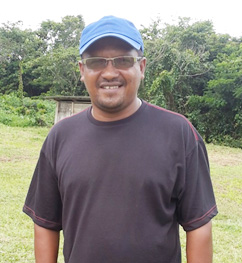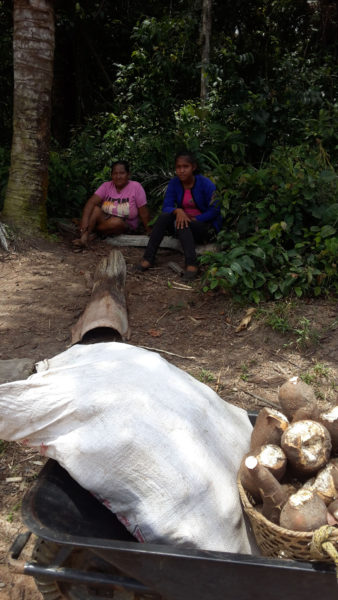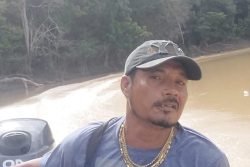The economic options for the residents of Moruca are limited mostly to fishing, logging, mining and farming. In the case of mining it could mean migrating as far away as Port Kaituma. The other three areas of economic activity realize only limited earnings for residents of the Region One community.
Moruca is a sub-district of Region One (Barima–Waini). The other two sub-districts are Mabaruma and Matakai. Moruca itself comprises eleven villages: Waramuri, Warapoka, Santa Cruz, Kokerite, Chinese Landing, Kwebena and Santa Rosa. Three Amerindian tribes live at Moruca: the Waraus, the Caribs and the Arawaks.
You get to Moruca by plane but the current state of airstrip means that this is not a viable option at this time. The other option is by river. Boats customarily depart Moruca around 05:30 hrs heading for the Atlantic. Once a boat enters the ocean it takes ten to 15 minutes, depending on a combination of the tide and the efficiency of the boat’s engine for it to arrive at the mouth of the Pomeroon River. After that, the journey to Charity takes half an hour.

The economy of Moruca depends heavily on bitter cassava. It is used mainly for making cassava bread and cassareep. The very existence of many families at Moruca depends on the quality of the cassava crop and that, given the vagaries of the weather, is an unknown quantity. When Stabroek Business visited Moruca a week ago the farmers were bemoaning the prevailing cassava prices. Alonzo Cornelius, a subsistence farmer from the community told us that just the day before fear of spoilage meant that he was forced to sell about a thousand pounds of cassava for $2,000 instead of the $4,000 that it was worth. As far as he was concerned it simply was not worth the effort.
Cornelius, who also serves his community as a councillor believes that the fortunes of farming at Moruca are partly a function of chronic official neglect. He says that farming methods remain primitive and there is no real scientific support for agriculture. A plot of land is used twice for planting after which the farmer moves to clear a new plot. It takes about one month to clear the succeeding plot of “raw forest” with cutlasses and axes. Most farms are family-owned and since there is no money available to hire labour (the cost of labour can be as high as $5,000 per day) land-clearing has to be tackled at the family level. After clearing the small trees, the large trees are cut and the area burnt. Afterwards, the land has to be cleared before it is ready for planting.
Community support is often available during the planting period. For an investment of providing a meal for about 20 volunteers you might get an acre of cassava planted in a day.
Sometimes the farmers take advantage of the virgin nature of the new lands to grow cash crops like plantain, bora, callaloo, cucumber, squash and peas before the cultivation of bitter cassava starts. These will sustain the family while they wait out the nine-month period for the cassava to mature. Cassava takes about nine months to mature. The cash crops are sold at the Kumaka market on Saturdays.

For the better-off residents, life can be considerably easier. A chain saw will significantly reduce the labour of land-clearing if the family is able to part with $200,000. A clearing period of two to three weeks can be reduced by as much as half. Planting takes place between January and April every year so that the farmers harvest their cassava crop simultaneously. This is largely responsible for the uncompetitive prices. Reaping takes place close to the end of the year.
Acoushi ants are the bane of the cassava crops’ existence. An entire farm can be ravaged overnight, and then farmers have to plant again. The plots are close to each other so that while one farm may be treated for the ants the next one or an unused plot of land may pose a threat. There are also farmers who simply cannot afford the cost of the treatment. It is an age-old problem which the farmers at Moruca have been unable to get rid of.
We met Theresa Benjamin and her granddaughter sheltering from the scorching sun under a tree on the road to Haimaracabra. With her was a wheelbarrow filled with bitter cassava which she had just cut. In the days ahead, she told Stabroek Business, she would be making cassareep for marketing at Charity. She was resting before wheeling the barrow home. Hiring a vehicle to take the cassava home would have cost her $3,000, an unacceptable incursion into her profit. She runs a five-acre farm with her three children and grandchildren. Every fortnight she makes the seven-hour journey to Charity to sell cassareep, using the family boat. The vessel and its 15 horse power engine, together, cost the family around $350,000. It doubles as a fishing vessel that is used by her husband so than when the boat is on a fishing trip they must hire a boat for $10,000 to make the return trip to Charity to sell their cassareep.
Geoffrey Francis, another Moruca resident, used to be in mining. He is the father of three girls and decided to quit the ‘gold bush’ on account of ‘issues’ with his family. He worked with government for a brief period after which he launched his own business, transporting passengers by boat from Kumaka to Kwanwatta, a ten-minute ride. There is a road between the two communities but its condition means that the journey by car would take half an hour and would cost more. Geoffrey’s boat accommodates six passengers and the cost for adult passengers is $600 for a one-way trip. Schoolchildren enjoy a significant concession, paying only $100. He had purchased the boat at Charity and it had cost him in excess of $700,000. These days, that is how he makes a living.
Boat operators are plentiful at Moruca. Clifford Henry, commonly known as ‘Peanut’ is one of four boat operators who ply the Charity – Moruca route. ‘Peanut’ is a veteran in semi-retirement. His son, Chris, is now in charge. The boat service makes about two trips per day. The first trip leaves Moruca around 5.30 am daily and arrives at Charity one and half hour later. He uses a 200hp engine. The trip costs $3,000. ‘Peanut’ is also a farmer. He sells coconuts but does not find it profitable. These days he prefers to leave the coconuts to fall to the ground. He does not consider a price of $400 for 50 dried coconuts to be worth his while. Other coconut farmers have echoed that sentiment. Cornelius says there is a need to diversify the Moruca economy if the standard of living is to rise. Limited markets for a handful of primary products point to the need for both diversification in the agricultural sector and the application of advanced technology to farming. What the farmers say is unacceptable is the fact that their livelihoods are sometimes hostage to foraging ants in a country where eradication of the problem ought not to pose too formidable a challenge.
But it goes beyond that. With limited market for the cassava bread and cassareep, the two by-products of bitter cassava upon which farmers at Moruca rely heavily, there is scope for Government of Guyana investment in infrastructure that can trigger the creation of a manufacturing sector.
Stabroek Business was told that there are plans on stream for the creation of a woodworking factory for the manufacture of furniture and other wood related products. Moruca has the lumber and some of the residents possess furniture-making skills. Those skills can be utilized to manufacture furniture for the 20 schools in the community.
Stabroek Business understands that the factory is likely to be completed by June this year. It is a Guyana Community Development Project which is being funded by the United National Development Programme (UNDP) and the Ministry of Indigenous Peoples Affairs.
Meanwhile, furniture is being bought at Charity and transported by boat to Moruca.








